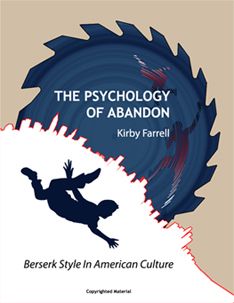
For an hour, a young white man sits in a Bible study group in a black church in Charleston, and all the while he’s nerving himself up to act out a superhero fantasy that he’s saving the white south from black rapists. Then he pulls out the pistol he bought with birthday money—this is the US, after all—and murders nine of the people around him.
The news builds on familiar terms: racism, hate crimes, extremism, neo-Nazis, white supremacy groups, and asks why don’t we call it terrorism?
But take a look at photos of the headlined killer.
In one, perhaps a selfie, he’s burning an American flag. What do you see? A skinny 21 year old white kid. He has a vacant, perhaps depressed expression and holds the flaming flag limply. In a photo taken in a garden, he’s surrounded by potted flowers, holds the Confederate flag, and has sunglasses propped on his nose.[1] He’s lightly outlined his eyes like war paint or a mask, and wants to look fierce, but only scowls like a sulking 15 year old. If he were not rapt in his fantasy, he would see that he looks as if the camera’s caught him squatting to take a dump at a Boy Scout latrine. Like the Norwegian killer Brevik, he’s imitating other rampage killers, but he can’t shake a pathetic infantile quality to his body language.
Seen this way, Dylann Roof is a young nobody trying to pump up his morale to cope with depression and panic. At an age when he’s supposed to be a man, he’s adrift. Play-acting at heroism, he’s a southerner identifying with a century-old romantic lost cause. The state still flies the Confederate battle flag in a juvenile gesture of self-importance. Apologists for the flag use smarmy arguments about heritage and history, but like the pathetic Dylann Roof, they “fight” to defend a wish that they’re “really” undefeated, courageous heroes. For political reasons, the flag has to occupy a nominal, compromise position on the statehouse ground, like a concession to a sulky adolescent. So the flag itself signals the sort of insecurity and disguised aggression that Dylann turned into an atrocious obsession.
Rampage killing is almost always about trying to claim heroic attention. Again, look at the body language in the photo: this is an immature nobody using copycat American rampage killing to make himself important. Even his name, Dylann, with the extra “n,” reveals an effort to stand out as an individual. If guns weren’t handy as gum, he’d be harmless. Maybe even free to grow up.
As a political symbol, the Confederate battle flag still signals a struggle over self-esteem. The old plantation aristocracy despised “niggers” not only to justify slavery, but also to give poor whites scapegoats to lord it over. Likewise, the elite romanticized war to offer low-status whites a route to self-esteem.
So here’s Dylann Roof acting out this absurdly outdated nonsense about nigger rapists and black hegemony as if its 1866 and the slaves are suddenly free and—whites fear—ready to retaliate for generations of brutality.
Dylann may be susceptible to mental illness, but you don’t need that possibility to see that he’s educated himself in the self-serving delusions around self-esteem in American culture—and in this case, southern American culture. He’s latched onto the south’s investment in warrior ideology and white privilege, but also gracious hypocrisy: the deceitful politeness that made him sit for an hour with the prayerful folks he was about to murder. Rant media and scurrilous politics have strengthened this pose in recent decades throughout the US, especially with a mixed-race president to despise.
In the bigger picture, Dylann embodies some of the stresses facing Americans in the new century. He’s unemployed, poorly educated, and armed. He’s able to navigate the internet well enough to find rampage killings to copycat, and copious false info about blacks and other scapegoats. Obsessed with messianic heroism (“Well someone has to have the bravery to take it to the real world, and I guess that has to be me”), he’s devised his own warped version of the neocon’s “global policeman.” In this respect he’s playing the script of George Zimmerman, who killed Trayvon Martin supposedly to defend his neighborhood.
But again, this juvenile “policeman” is struggling quixotically to grow up. Like his country, Dylann imagined he was only killing in “self-defense.” And like his country, he is in the grip of obsession. After all, the nation feels it has to take sides in every global quarrel; it wastes lives, sanity, and trillions on phony enemies such as Saddam Hussain’s Iraq, and having torn apart the middle east, keeps pouring more weapons, money, and “advisors” into the chaos it’s created, partly because we have an oversupply of military as well as civilian weapons.[2] Like a nation relying on sneaky drones and snipers, Dylann Roof wanted to save his world by taking his concealed pistol into a church and shooting people like fish in a barrel.
I'm well aware that in opinion polls, the public says it trusts the military more than most government institutions. That in itself has much to tell us about the culture surrounding the copycat rampage killers regularly making headlines among us.
Dylann Roof may be guilty of “racism” and “terrorism.” But such portentous words distract attention from stunted development, childish fantasies, and obsession. In a horrible way he was play-acting, trying to make his fantasy real in silly photos and a "manifesto." And he couldn’t see that. That's the frightening thing: it can be really difficult to recognize the quality of play in our experience. Like so many other young Americans, he could become a pathetic flag-waving killer because such fantasies are as plentiful as guns in his culture, and like guns, they’re disguised in pseudo-adult rhetoric about self-defense and me-first freedom.
We can do better than that.
1. Frances Robles, “Dylann Roof Photos and a Manifesto Are Posted on Website,” NY Times, 6.20.2015.
2. (Col.) Andrew J. Bacevich, “Naming Our Nameless War,” Guardian, June 20, 2015. //www.theguardian.com/commentisfree/2013/may/28/naming-our-nameless-war
-----------------------
Now available from Leveller’s Press and Amazon:

When behavior becomes a cultural style, berserk abandon is terrifying yet also alluring. It promises access to extraordinary resources by overthrowing inhibitions. Berserk style has shaped many areas of contemporary American culture, from warfare to politics and intimate life. Focusing on post-Vietnam America and using perspectives from psychology, anthropology, and physiology, Farrell demonstrates the need to unpack the confusions in language and cultural fantasy that drive the nation’s fascination with berserk style.
<<This book amazes me with its audacity, its clarity, and its scope. We usually think of ‘berserk’ behaviors—from apocalyptic rampage killings to ecstatic revels like Burning Man—as extremes of experience, outside ordinary lives. In fascinating detail, Farrell shows how contemporary culture has reframed many varieties of abandon into self-conscious strategies of sense-making and control.
Abandon has become a common lens for organizing modern experience and an often troubling resource for mobilizing and rationalizing cultural and political action. This landmark analysis both enlightens and empowers us.>>
—Les Gasser, Professor of Information and Computer Science, U. of Illinois, Urbana-Champaigne.



